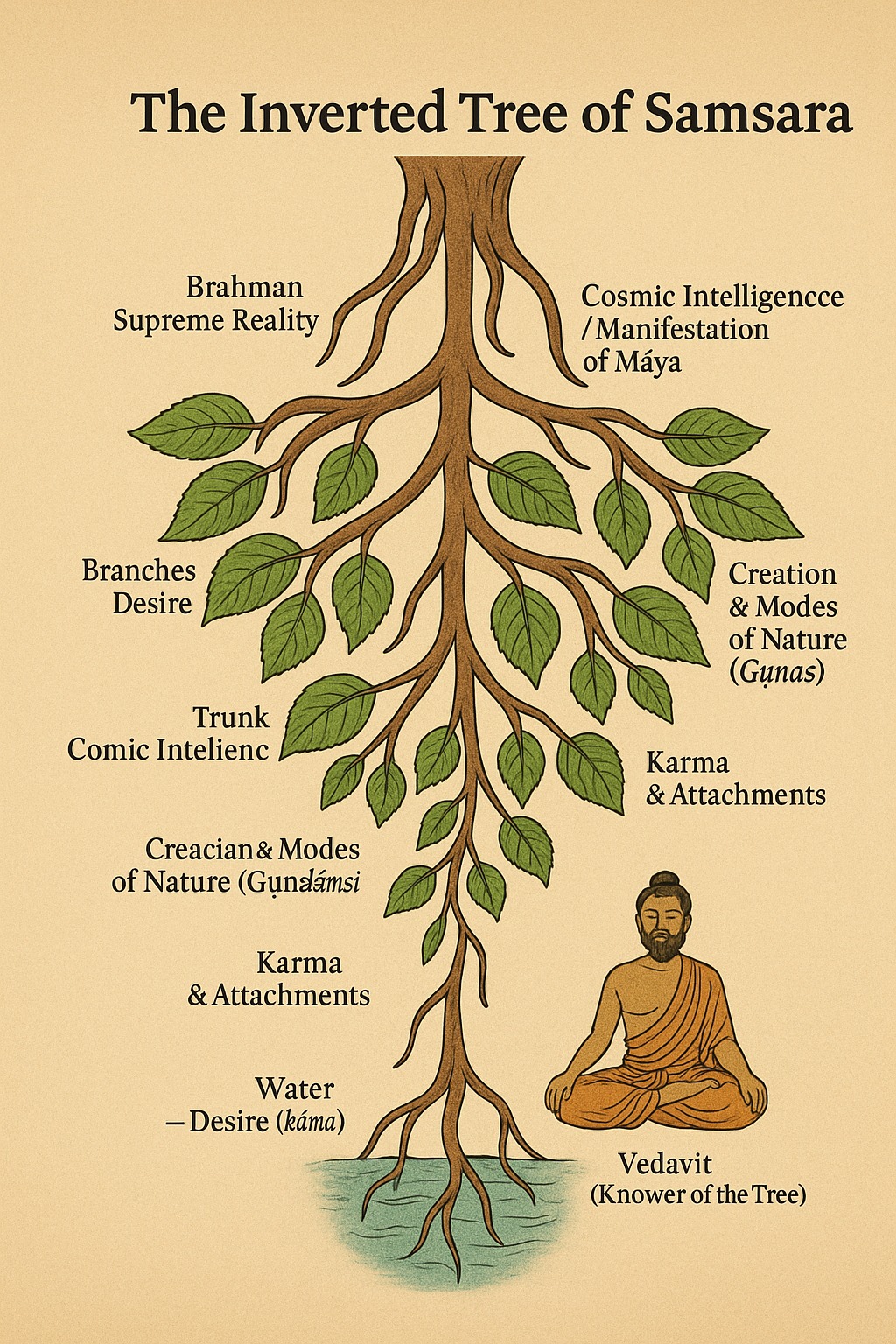Chapter 15, Verse 1
ūrdhva-mūlam adhaḥ-śākham aśvatthaṁ prāhur avyayam
chandāṁsi yasya parṇāni yas taṁ veda sa vedavit
The Blessed Lord said: There is a banyan tree which has its roots upward and branches downward. Its leaves are the Vedic hymns. One who knows this tree truly is the knower of the Vedas.
Chapter 15, Verse 2
adhaś cordhvaṁ prasṛtās tasya śākhāḥ | guṇa-pravṛddhā viṣaya-pravālāḥ
adhaś ca mūlāny anu-santatāni | karma-anubandhīni manuṣya-loke
Its branches extend downward and upward, nourished by the three gunas (modes of material nature). The sense objects are its buds. Its secondary roots spread below in the human world, binding the soul through actions (karma).
🌳 Symbolic Comparison and Meaning
Element in the Metaphor | Represents in Reality (Philosophical Meaning) |
Upside-down Tree (Aśvattha) | The entire material world (samsara), which appears real but is actually illusory and rooted in the higher metaphysical reality (Brahman). |
Roots Upward (ūrdhva-mūlam) | The root is Brahman or the Supreme Reality, situated beyond the material world. The source is spiritual, not material. |
Branches Downward (adhaḥ-śākham) | The various manifestations of creation—celestial, human, and subhuman realms; social orders; life experiences; descending into worldly entanglement. |
Leaves = Vedic Hymns (chandāṁsi) | Leaves give life to the tree—like Vedic knowledge sustains worldly activity (karma-kāṇḍa) and the cycles of existence. But they also contain the clue to transcendence. |
Branches nourished by Gunas | The material qualities—sattva (goodness), rajas (passion), and tamas (ignorance)—feed the evolution of life forms, thoughts, desires, and experiences. |
Buds (viṣaya-pravālāḥ) | The sense pleasures or objects of desire—the new growths that lure the soul and perpetuate engagement in worldly actions. |
Lower Roots (adhaḥ-mūlāni) | Karmic attachments that bind the jīva (soul) in the human world through repeated births and actions. |
Water (not explicitly mentioned here) | In commentaries (like Shankara’s), water represents desire, which nourishes the tree of samsara and makes it grow—just like water sustains a tree. |
🧠 Deep Insight
This inverted tree model is a spiritual X-ray of how we are entangled in maya. What appears to be the root (the physical world) is actually a shadow reflection. Our origin is divine (root above), but we get caught in illusory branches of karma, relationships, ambitions, and pleasures. Only a Vedavit (knower of the true essence of Vedas) can trace the illusion back to the root and sever this bondage.
Confused! Don’t worry. See the below.
🕉 The Inverted Tree of Samsara
A symbolic model of existence drawn from the Bhagavad Gita
1. Roots Above (ūrdhva-mūlaḥ) – Brahman / Supreme Reality
Symbolize the source of all existence—Pure Consciousness or the Absolute.
Desireless, eternal, unmanifest.
The true foundation of life, yet unseen to most.
2. Trunk – Cosmic Intelligence / Manifestation of Māyā
The main axis connecting spirit and matter.
Acts as the channel for divine energy to manifest as creation.
Sustains all levels of the material cosmos.
3. Branches Downward (adhaḥ-śākham) – Creation & Modes of Nature (Guṇas)
Represent diverse expressions of life: gods, humans, animals, thoughts, cultures.
Nourished by sattva (purity), rajas (desire), tamas (ignorance).
Spread across higher and lower planes of existence, showing spiritual elevation or degradation.
4. Leaves (chandāṁsi) – Vedic Hymns & Ritual Knowledge
Like real leaves nourish the tree, Vedic knowledge sustains karmic life.
Indicative of karma-kāṇḍa (ritual action), which upholds samsara unless transcended.
A pointer: If studied rightly, they lead toward liberation.
5. Twigs / Buds (viṣaya-pravālāḥ) – Sense Objects
The delights and distractions of worldly life: wealth, pleasure, power.
Lure the jīva deeper into bondage by fueling desire and ego.
6. Lower Roots (adhaḥ-mūlāni) – Karma & Attachments
These bind the soul to repeated birth and death through action and its results.
Reach downward into the human realm—where free will operates, and liberation is possible.
The strongest bindings are formed here due to identification with body, name, and role.
🌊 Water (implied by commentaries) – Desire (kāma)
Though not in the verses, water is said by sages (like Shankara) to represent desire, which feeds the entire tree.
Without desire, the tree cannot grow.
🧘♂️ Vedavit (Knower of the Tree)
One who truly understands this tree is a knower of Truth.
He cuts it with the axe of detachment (asaktī) in later verses (15.3–4) and returns to the imperishable root.



